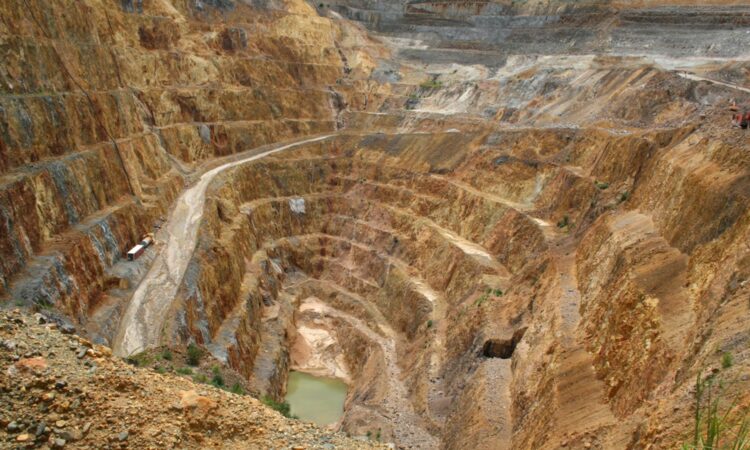
By Ollie Cooper, Money blog reporter
In June, gold hit an all-time high price of £62,022.60 per kilogram.
Rising prices come as geopolitical tensions heighten, economic conditions remain uncertain and financial markets continue to wade through a period of volatility.
The news has also raised questions of what would happen when mines run out of this finite resource.
When will we run out of gold?
Some experts have estimated we’ll run out of gold to mine as soon as 2050.
Around 240,000 tonnes of gold has been mined in total, according to the US Geological Survey, but the below-ground stock of gold reserves was estimated to be around 50,000 tonnes back in 2020.
It’s thought the annual production rate of new gold is around 3,000 tonnes per year – meaning that 2050 figure looks realistic by means of basic arithmetic.
It’s important to stress that these figures are estimates – and you also have to remember that gold, a virtually indestructible metal, can be recycled, so it is impossible for us to “run out” completely, even when the supply from mines dries up.
But there would still be major global consequences.
“Advances in mining technology and processing methods could increase the efficiency of gold extraction and make previously uneconomical deposits viable – and this would potentially extend the lifespan of current reserves,” Pete Walden, managing director at BullionByPost, told Sky News.
“Additionally, new gold deposits may be discovered, which will extend the timeline for depletion.
“While its speculative, I don’t think it is too wild to assume we will face significant depletion within the next 20 to 30 years.”
To get a feel for what running out of fresh supplies may look like, Sky News spoke to Rick Kanda, managing director at The Gold Bullion Company.
Value of gold itself
The fundamental principle of supply and demand dictates that as the supply of gold dwindles, its price will likely skyrocket.
“Seeing the availability decline, investors would rush to acquire and hoard gold, increasing its cost,” Rick explains.
Historically, gold has been a safe-haven asset, meaning its value increases during economic uncertainty or scarcity.
But as gold becomes prohibitively expensive, investors would likely turn to other precious metals.
Those could include silver, platinum, and palladium, Rick says.
“Their use in various industrial applications and jewellery makes them attractive alternatives.
“These metals, often seen as substitutes for gold, would also experience price increases due to heightened demand.”
Would this affect currency?
Since the abolition of the gold standard (1931 in the UK, 1971 in the US), most global currencies are no longer directly tied to gold.
“This shift to fiat currencies means central banks can print money independently of their gold reserves,” Rick explains.
“Therefore, while the scarcity of gold might influence the value of gold-backed securities or assets, it wouldn’t directly affect the value of currencies like the pound or the dollar.”
However, it could affect investor confidence and the perceived stability of economies that hold significant gold reserves.
How would this affect banks and their stores?
Institutions like the Bank of England and Fort Knox hold substantial gold reserves.
“If gold prices rise significantly, these institutions might consider liquidating some of their holdings to capitalise on high prices,” Rick says.
“However, the gold wouldn’t disappear; it would simply change ownership,” he adds.
The new owners would still require secure storage, so there would still be demand for extensive vaulting services like those seen in the BoE and Fort Knox.
Impact on jewellery and industry
“The cost of gold items in the jewellery industry would substantially increase,” Rick says.
This could decrease demand as consumers turn to more affordable alternatives or buy less.
“High prices might also lead to innovation in the design and use of mixed materials, reducing reliance on pure gold.”
Gold isn’t just used in jewellery – it’s critical for other industries too, like electronics.
“Beyond gold jewellery, the most affected products would be those in the medical and electronics sectors,” Rick says.
Gold is used in medical devices because it is corrosion-resistant and doesn’t harm our bodies.
“Gold is a crucial component in electronics due to its excellent conductivity and resistance to corrosion.
“A shortage would lead to supply chain disruptions and increased costs for manufacturers of electronic components, including smartphones, computers, and advanced medical equipment,” Rick says.
“Companies might need to invest in research to find alternative materials or more efficient recycling methods to mitigate these impacts.”
Economic shifts
As gold is a crucial commodity, significant price fluctuations can affect the global economy.
While the world might still have enough gold, reducing new annual supplies could increase gold price volatility.
“This volatility can impact industries that rely heavily on gold, such as electronics and jewellery, leading to higher production costs and potential economic instability in those sectors,” Rick says.
Is the industry preparing for this?
All of this can make for quite worrying reading – but the industry is taking steps.
“Miners are continually exploring new sites and revisiting previously unviable locations,” Rick explains.
As gold prices increase, sites that were once too costly to use might become economically feasible – potentially leading to the development of new mining operations, and thus ensuring a continued supply of gold.
There is ongoing research into recovering gold from unconventional sources.
“For example, the National Ocean Service estimates there are 20 million tonnes of gold in the Earth’s seas,” Rick says.
“Currently, these fine particles are not recoverable, but if gold prices rise enough, it could become economically viable to develop cost-effective recovery methods.”
The industry is also focusing on improving recycling technologies to reclaim gold from electronic waste and other sources.
Enhanced recycling methods can lessen the impact of reduced new supplies by ensuring that existing gold remains in circulation.






